#Torque 3D
Text
Torque 3D Game Development Cookbook
Torque 3D Game Development Cookbook - Read more
In DetailTorque 3D is a popular game engine that supports you in every step along the way to making your game a reality. Even with all of the power and tools that Torque 3D provides, finishing a high quality 3D game requires time and knowledge."Torque 3D Game Development Cookbook" is a practical guide that takes you through each of the major steps on the journey to creating your game, while learning a few tricks along the way.The recipes in this book start off with learning some of the finer points about TorqueScript. The book then moves on to each of Torque 3D's subsystems and ends with a variety of game play recipes.The various topics covered include activating level-specific game code and scheduling game events, dragging and dropping items between windows to work with an in-game inventory system, and covering the seams between objects with well placed decals. Some of the advanced topics include writing custom shaders and postFX, using zones to improve rendering performance, and enhancing your game's ambience through sound.Once you are done with Torque 3D Game Development Cookbook you'll be on your way to creating amazing 3D games and gain expert knowledge of Torque 3D.ApproachCookbook; packed with recipes to help you create amazing 3D games with Torque. The recipes provide clear step-by-step instruction and practical examples to advance your understanding of Torque 3D and all of its subsystems.Who this book is forThe book is written for professional and indie game developers that have basic knowledge of TorqueScript, are acquainted with Torque 3D's built-in tools, and wish to take their skills to the next level. Having gone through the comprehensive Torque 3D 1.2 FPS game tutorial on the GarageGames website (or its equivalent) is assumed.

#Torque 3D#quality 3D game#popular game engine#finishing a high quality 3D game#Torque 3D 1.2 FPS game#scheduling game events
0 notes
Photo
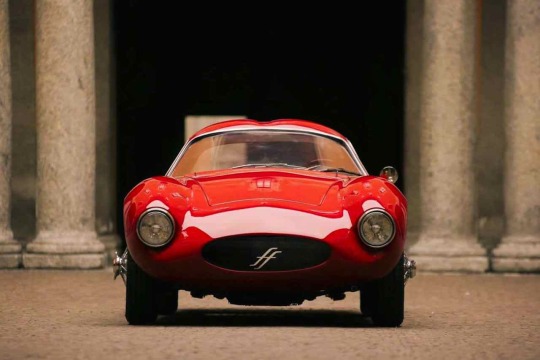
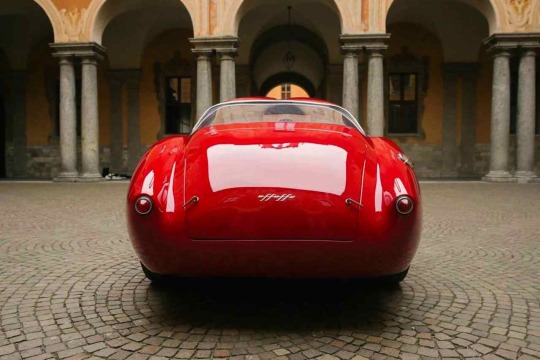
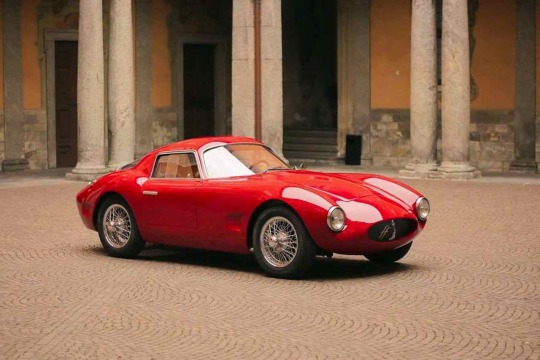
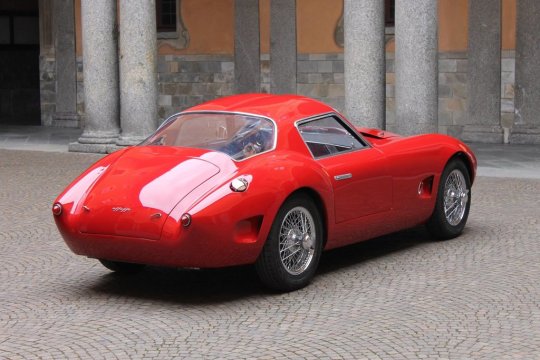



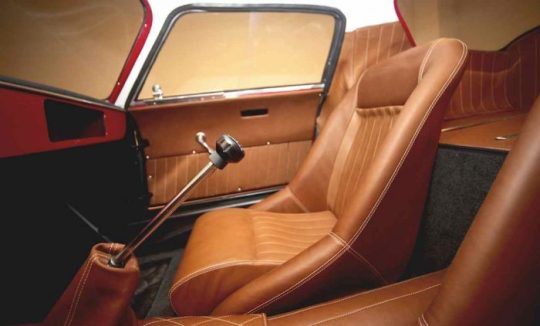
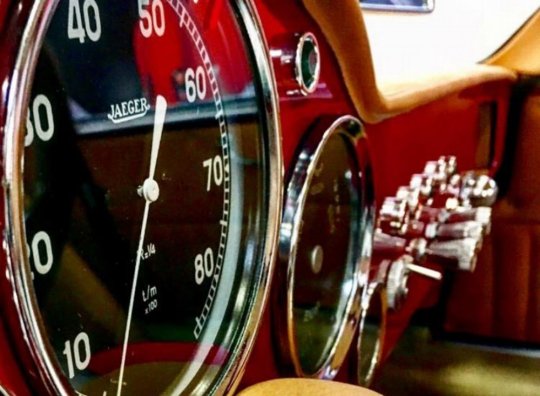
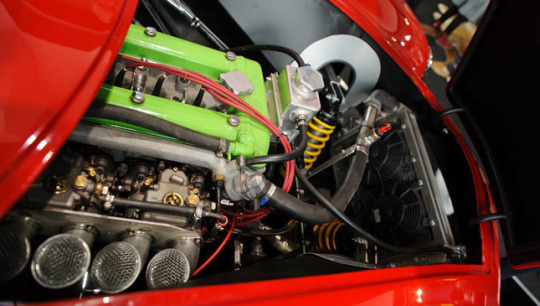
Effeffe Berlinetta
Berlinetta is a name of the past, a name that conjures up a very specific type of car: a high-performing sports car with closed bodywork, a 2-seater (or 2+2 at most). The name Berlinetta embodies all the philosophy of the first car made by Effeffe. A car built today in exactly the same way as craftsmen moulded the famous GTs in the late 1950s: the mechanics borrowed from the series and redesigned to suit new needs, a hand-made chassis and bodywork. All starting from a blank sheet. An original car with a strong personality, in form and in deed, which is the best possible homage to the skill of these craftsmen. A generation we have perhaps forgotten, that offered the Italian car tradition - and the history of motoring generally - plenty in terms of uniqueness, charm and design. A product built and finished by hand, like in the past, with a tubular chassis, hand-beaten aluminium bodywork and wire wheels, seeking to guess and please the taste of the owner, expressing a timeless character.
The Berlinetta prototype was born in 2014, little more than a scale model. Made and finished, but not running: the mechanics are approximate, and it has never really been fine-tuned. But it is beautiful. An authentic time-machine. It seems as if it has just been found in a hay barn and dusted down. In addition, being practically a style model, its lines are pure and smooth, not “dirtied” by license plates or indicators. So beautiful, in fact, that, almost as a game, the Frigerio brothers sent a few photos to the people in charge of the Concorso di Eleganza di Villa d’Este. And, a surprise, they sent an invitation to present the Berlinetta in the Concept Cars category. A dream within a dream, the self-built car made its début and the world’s most prestigious and glamorous elegance competition.
Along with the interest and pleasure shown immediately by the public and the media, this would have gone to anyone’s head. But as we know, the Frigerio brothers aren’t the sort of people who sit on their laurels, and they decided the play another chip. They realised that their idea could become something more than just an adventure, and decided to exploit their years of relationships, acquaintances, friendships and skill to set up a workshop to produce the Berlinetta in small series. An exclusive, tailored and fully customisable product. Built as in the past by a handful of old craftsmen wanting to get back in the game, but with the help of the best technologies available today.
The lines of the Berlinetta need no explanation. They are a well-balanced mix of classic, late-50s stylistic elements, from the muscular bumpers to the oval grille, a hint of rear fins and the double bubble roof. The definition of the lines of the car talks of an approach that is about as poetically anachronistic as you can get. The Frigerio brothers started by placing the mechanics and seats on the floor, tracing the basic outline around them with chalk, then gradually building the chassis, welding, cutting and welding again. Following the curves of the tubular metal frame, they then moved onto the bodywork, beaten entirely by hand in aluminium according to the artisanal sensitivity of Vittorio, who has a good hand, assisted by a few panel beaters with forty years’ experience. And from there, the project moved on in a kind of reverse engineering, working backwards by making 3D scans of the shapes to produce the drawings and designs.
Style and proportions have that instantly recognisable Italian flair, as does the passenger compartment, entirely leather-lined with a dashboard painted in the same colour as the car, and the Alfa Romeo-derived mechanics.
Who, working according to the Fia Gr2 specifications of the 1971 European Touring challenge, they were able to achieve around 200 HP at 6800 rpm, with maximum torque of around 30 Kg/m at 4400 rpm, on the road with no technological support.
221 notes
·
View notes
Text


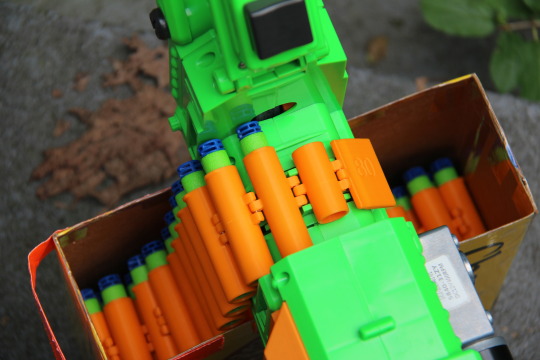


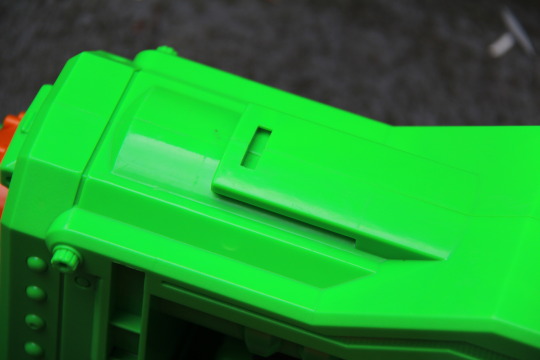
Adventure Force Enforcer work in progress:
Current stats: ~165 fps, 350 rounds per minute, 2 x 80 dart belts.
I always wanted to mod one of these but I've had several failed attempts. The stock gear box is jus too flimsy and breaks easily when upping the speed and voltage; so I designed a 3d printed mount to hold a much stronger motor and gearbox. The one I chose is probably overkill in terms of torque but it's not like I could just pop in an N90 or one of those smaller hobby gearboxes that Out Of Darts sells, it still needs to be able to pull a belt. Unfortunately the gearbox I got is a little slow on the fire rate, the tag said 400 rpm but it's only getting about 350. I did find a gear box of the same dimensions and style that advertises 470 rpm so I've got that on the way and it should be able to just screw into the same mount. The daybreak wheels in the internal pictures ended up being a bit too tough on the darts than I would prefer as the belt drive doesn't quite align the darts perfectly canter like a magazine would, so many darts would feed closer to the side and get pretty chewed up. So I replaced the wheels with Containment Crew Cyclone wheels, and due to there low concavity it doesn't matter as much if a dart is fed in slightly to the side. I also made a clip that can screw into and clamp down on a cereal box to act as a box magazine for the 80 round belt though the boxes are large enough it could probably hold 100. I took it to the TANG war last Sunday and it managed to do some work during one of the carpe games but during the second round I had loaded it with brand new just opened the box darts and the belt was a bit too tight on the fresh darts and caused several feeding issues.
28 notes
·
View notes
Photo

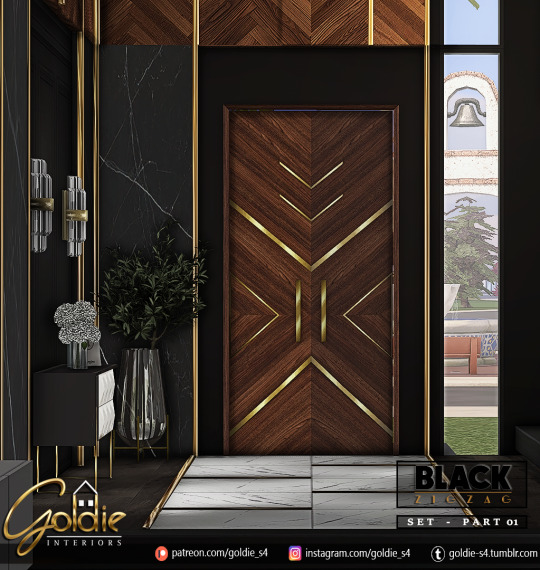
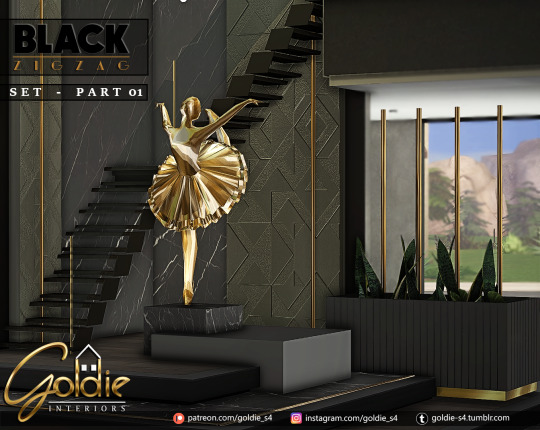
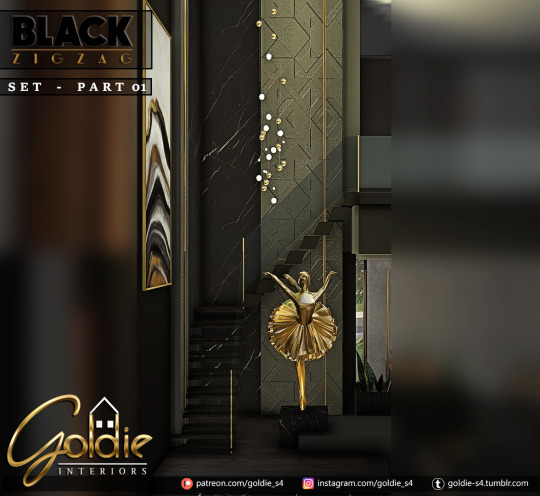
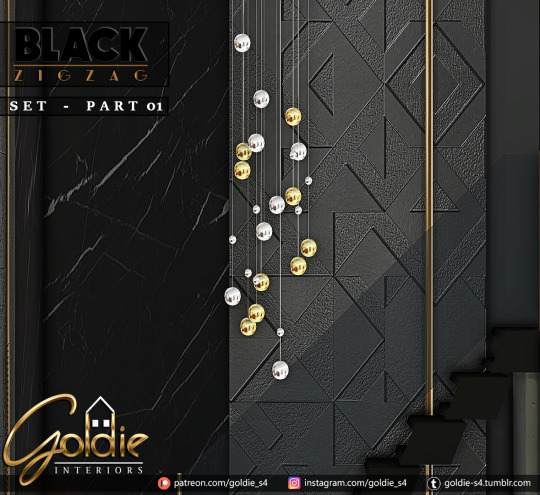

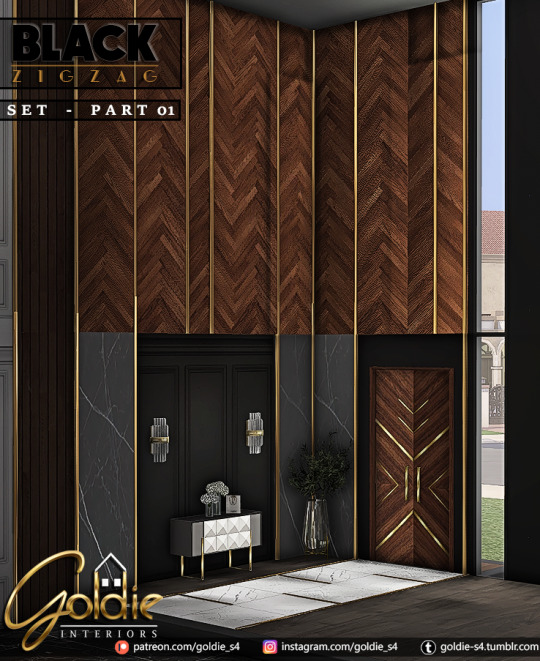



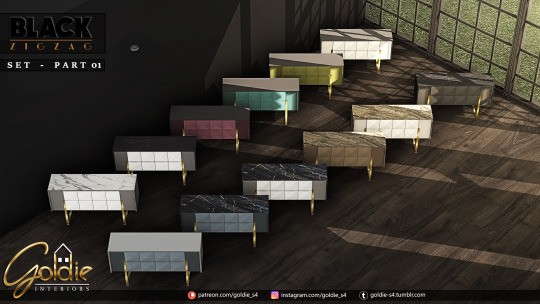



|_Black ZigZag_| - CC Set Part 01
Hello! 🌷Part 01 of the cc set created for my next build (Black ZigZag).
The Build is still a w.i.p , so I decided to publish the first part of the cc set that I created for it.
You can find more images for the set on my Instagram page.
Link to the set is at the end of the post.
Details:
6 new objects, all meshed by me, except for the Dancer statue, I converted it from a 3D model.
Hq textures, with all maps.
All tested in game.
Custom thumbnails.
All base game compatible.
10-15 swatches.
Polycount text file is attached.
You can find the objects in game by typing (Goldie) or (Black Zigzag) in search.
- If you find any issues with any of the objects, please let me know.
- Please read my t.o.u before downloading.
Links for the cc I used in the build and shown in the screenshots:
Paper Gift Bag and Hydrangea in Big Glass Vase, are from the [Millionaire Quinn Walk in Closet] set, By @cowbuild >> Link
Samara Sconce, from the Samara Dining Set, By @blueteas >> Link
Wall Panelling, from London Set, By @felixandresims >> Link
Wooden Floors, By @pralinesims >> Link
White Marble Floors, By Torque >> Link
Black Marble Floors, By @pralinesims >> Link
Stairs and Railing, From Elevare set, By @syboubou >> Link
Marble Painting, from Set Collection #3, By @sims4luxury >> Link
Plants in box planter, from Planties set, by @ts4novvvas >> Link
Plant beside the door, from Vintage Collection, By @ts4novvvas >> Link
Glass Vase beside the door, from Not Christmas dinner set, By @ts4novvvas >> Link
Black neutral wallpaper, By @ts4novvvas >> Link
Wood vertical siding wallpaper, By @peacemaker-ic >> Link
Windows, from Artus set, By @syboubou >> Link
Many thanks to all the cc creators! you're so talented! 🌸
Thank you, and Have fun! 🌷
Download Link ( Patreon Early Access, Public on June 28, 2022 )
#S4CC#TS4#sims 4 objects#ts4cc#ts4 build#thesims4#the sims 4 cc#sims4cc#sims4builds#sims 4 simblr#s4 download#s4 buy mode#s4 build#ts4 objects#sims 4 cc finds#cc finds#simstagram#sims#sims4#goldie_s4_objects#goldie_sims4#sims 4 custom content#goldie_s4_hallway
217 notes
·
View notes
Text
Pravaig DEFY SUV India: A Comprehensive Review of Design, Price, Range, Features, Specs & More

The Pravaig Defy SUV emerges as a pioneering creation in India’s automotive industry amidst the gradual global shift toward Electric Vehicles (EVs). Crafted meticulously to combine efficiency, reliability, and style, this innovative electric car beckons to those embracing the electric revolution while offering a compelling choice for both prospective EV buyers and the merely curious about this transformative mode of transportation.
Unveiled on November 25, 2022, in India, the Pravaig Defy EV epitomizes an efficient and dependable daily mode of transport that aligns with the safety standards of traditional gasoline-powered vehicles while significantly reducing carbon footprints. The SUV offers an impressive array of features, including sleek design elements, all-wheel drive, spacious interiors, comfortable seating, and an unwavering commitment to safety — all in a single variant, providing a streamlined choice for those venturing into the realm of electric driving.
The Defy’s exterior presents an angular and bold styling, blending rugged aesthetics with subtle crossover elements, creating what Pravaig aptly terms “brutal sophistication.” From the sharp front-end cuts to the panoramic fixed roof, this SUV exudes an aerodynamic design boasting a drag coefficient of 0.33. Additionally, its 18-inch alloy wheels and optional “aero covers” not only enhance its range but also contribute to the SUV’s highway driving efficiency.
Step inside, and sustainability takes the center stage within the Defy’s interior, showcasing sustainable fabrics crafted from recycled materials like PET and vegan leather upholstery. The cabin offers a seamless blend of technology and comfort with a 15.6-inch touchscreen display, onboard gaming capabilities, 3D sound from Devialet, and separate climate control zones for front and rear passengers. The SUV’s security measures, including a unique key card and a robust data privacy policy, reinforce the user’s peace of mind.
The Defy’s safety suite encompasses adaptive LED headlamps, a 360-degree camera system, and a 77GHz solid-state radar. Meanwhile, its dedicated skateboard platform, housing a 90.9kWh lithium-ion battery, positions the Pravaig Defy at the forefront of sustainable electric powertrains. The dual electric motor setup delivers an impressive 407 horsepower and 620 Nm of torque, offering an exhilarating driving experience comparable to established EV SUVs.
Charging options are versatile, allowing owners to opt for home charging using an optional 7.2kW home charger or rapid charging at 150kW DC stations. These charging solutions, coupled with a range of over 500 kilometers, cement the Defy’s practicality for daily usage.
Pravaig’s emphasis on user data security and a comprehensive service network spanning across 34,000 PIN codes in India complements the Defy’s overall offering, ensuring a reliable and customer-centric ownership experience.
In conclusion, the Pravaig Defy India spearheads India’s electric mobility sector, combining striking design, sustainability, robust powertrain, and user-centric features into a package that epitomizes the future of electric vehicles.
#best electric bike under 1.5 lakh#electric bike upcoming#top 10 electric bike company in india#top 5 electric bike in india#top electric bike company in india#electric car brands#best electric car under 10 lakh#best electric car in india#electric car company in india#top 10 electric car companies#ev car brands#best electric scooter#best electric scooter in india#electric scooter in india#top electric scooters in india#best electric bicycles in india#electric bike list#top electric bicycles#electric auto companies#electric bus price in india
2 notes
·
View notes
Text
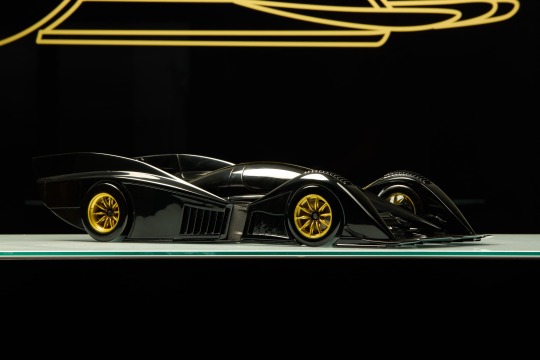
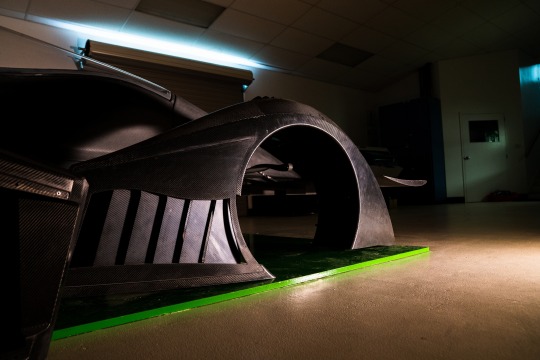
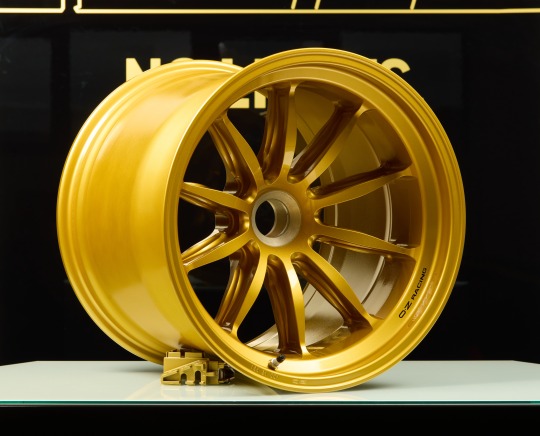

Rodin FZERO
New Zealand’s Rodin Cars has released more production details of its track special; the FZERO. The no compromise hypercar boasts 1176 horsepower from an all-new 4.0-litre V10 twin-turbo hybrid motor (built and designed from the ground up to Rodin Cars specifications) and should be capable of speeds in excess of 360 km/h. With a weight of just 698kg wet, the car is expected to have a power-to-weight ratio of 1.662 (PS/kg)
Building a car without restrictions of road laws or race series regulations, means it can be developed with no limits, allowing for performance that would otherwise be unobtainable. The singular goal of the Rodin FZERO is to be the fastest car around track, without exception.
CHASSIS, WEIGHT & DIMENSIONS
As the car is made to attack lap times, the emphasis of the FZERO is on weight and airflow aerodynamics. The chassis is constructed from nose to tail of carbon fibre composite, with all components manufactured on site at Rodin Cars.
ENGINE
Designed and developed from the ground up by Rodin Cars and in conjunction with famed engine manufacturer Neil Brown Engineering, the Rodin FZERO is powered by a revolutionary 4.0-litre V10 twin-turbo engine with the assistance of an electric power unit.
At just 132 kg, the engine named the RCTEN, is designed to be the lightest and most compact V10 ever built. A very impressive accomplishment given the engine hasn’t compromised on power, still producing a combined 1176 PS and 1026 Nm of torque. All whilst revving all the way up to 10,000 rpm.
DRIVETRAIN
A bespoke gearbox unit manufactured in conjunction with Ricardo UK gives the FZERO 8 gears whilst only adding just under 66kg. The gearbox is encased in a titanium 3D printed case, printed on site in Rodin Cars’ state-of-the-art 3D printing facility.
The differential is hydraulic, and computer controlled.
BRAKES, WHEELS AND TYRES
Weighing just 698kg, the FZERO is ultra-responsive to minimal braking force. However, the car has been equipped with front and rear 380mm PFC Carbon-Carbon brakes, with Titanium callipers (6-piston front and 4-piston rear). The braking system has both ABS and traction control.
Not just used for stopping the car, the brakes also offer regenerative braking from the hybrid system.
The wheels are a bespoke set of 18-inch forged magnesium rims, manufactured in conjunction with OZ Racing and produced to F1 standards. The rims are 18 x 14-inch at the front and 18” x 16-inch at the rear.
The tyres are a race-spec full-slick compound developed by Avon and can be changed depending on weather.
AERODYNAMICS
The massive wings and floor of the FZERO can produce up to 4000kg of downforce, which when compared to the cars weight of just 698kg is impressive.
With only 27 units planned for sale the Rodin FZERO promises to be a rare and exceptionally fast track day weapon, offering performance than only the best drivers will be able to fully utilise.
36 notes
·
View notes
Text
Magnetic guidewire steering at ultrahigh magnetic fields for medical imaging

Magnetic guidewire steering at ultrahigh magnetic fields for medical imaging.
Physicists and bioengineers can manipulate magnetically driven guidewires by using remote magnetic steering with scope for minimally invasive medical procedures. Magnetic steering strategies are presently limited by low magnetic fields, thereby preventing their integration in medical systems operating at ultrahigh fields, including magnetic resonance imaging (MRI) scanners. In a new study now published in Science Advances, Mehmet Tiryaki and a research team at the departments of physical intelligence, biomedical engineering, and medicine in Germany, Switzerland, and Turkey, developed a magnetic guidewire design alongside steering strategies at ultrahigh fields.
The work demonstrated an extensive research scope, alongside its potential for in situ re-magnetization. The outcomes illustrated steering principles of magnetic guidance made of neodymium magnets and a fiber optic rod in a preclinical magnetic resonance imaging scanner. The newly developed ultrahigh field magnetic actuation framework can facilitate next-generation magnetic automation to function in clinical MRI scanners.
Advancing the magnetic resonance imaging (MRI) system
Despite a decade-long development of methods for magnetic resonance imaging, the technology has shortcomings compared to X-ray fluoroscopy. The ionizing radiation-free nature of X-ray fluoroscopy alongside its superior soft tissue contrast, makes it a more advanced alternative. The MRI system is currently limited by the workspace area in the scanner and its lower resolution, leading to a range of new proposals to improve the method.
For instance, a completely remote MRI-powered actuation approach can integrate a ferromagnet permanent magnet for intuitive three-dimensional (3D) steering. However, the method requires real-time software access and added power to function inside an MRI scanner. In this work, Tiryaki and colleagues presented an ultrahigh field magnetic guidewire steering strategy in the MRI scanner and demonstrated its steering capacity in physiologically relevant 3D vascular phantoms with the arterial flow, as well as during MRI scanning in the kidney of an animal model.
Magnetizing permanent magnets at ultrahigh fields
Permanent magnets such as neodymium magnets are commonly used during magnetic actuation for high magnetic torque and force transmission at low magnetic fields. Permanent magnets are developed with a constant magnetization vector aligned to the easy axis of the magnet at low magnetic fields. While physicists have studied the magnetic theory of permanent magnets at ultrahigh fields, they remain to investigate effects of the concept during automated magnetic actuation.
For instance, at ultrahigh fields, permanent magnets assume the form of soft magnets. The team, therefore, examined the magnetization vector and calculated the magnetic force and torque acting on permanent magnets. They focused on bulk neodymium magnets and used a vibrating sample magnetometer to deduce magnetic material constants, and studied the effects of magnetic hysteresis, to verify the strength of magnetization.
Magnetic actuation method at UHF. (A) Magnetization at low fields, B < 0.1 T. The red and blue colors represent the direction of the easy axis (C). (B) Magnetization at high fields, B >> 0.1 T. The permanent magnet is magnetized substantially by the external magnetic field. (C) Magnetization curves of the cylindrical neodymium magnet measured inside a vibrating sample magnetometer at different θ. The magnet's magnetization in the x direction is measured, while the magnetic field is swept from 0 to 1.8 T in the x direction. (D) Magnetization vector alignment as a function of the easy axis alignment at different external field strengths. (E) Magnetic fields and gradients in the x direction of the MRI scanner. (F) Model-based magnetic torque acting on the cylindrical magnet as a function of the magnet orientation. The magnet is in its saturation regime for the solid lines and nonsaturated regime for the dashed lines. The direction of the torque is shown on the schematic. (G) Magnetic force as a function of the magnet position in the MRI scanner for different magnet orientations. The solid lines represent the force estimated with the magnetization model using the MRI magnetic field and gradient measurements. The dashed lines are the linear model estimation in the nonsaturated region. The dots are the force sensor measurements in the experiments. (H) The discretized Cosserat rod model, including the magnetic actuation. (I) Schematic of the magnetic actuation simulations. (J and K) The maximum rotation and rotation range in the simulations as a function of the guidewire thickness. Credit: Science Advances (2023). DOI: 10.1126/sciadv.adg6438
Magnetic actuation in the MRI scanner and guidewire design
Tiryaki and colleagues measured the magnetic field and magnetic gradient in the MRI scanner to model magnetic torque and force. They calculated the magnetization angle and torque acting on the permanent magnet at ultrahigh fields and investigated the design of the accompanying flexible construct that formed the elastic core of the guidewire, and optimized the stiffness of the flexible body to magnetically actuate guidewires and maneuver the magnetic actuation system.
The team used open-source software and developed a Cosserat rod model dynamic simulation to mimic the shape of the guidewire and included elastic and gravitational forces to understand their influence on MRI magnetic force and torque. They performed bending simulations to validate Young's moduli and other parameters underlying guidewire dynamics to proactively use the magnetic guidewires.
Magnetic steering modes and in situ magnetization
The scientists studied a variety of automated magnetic actuation systems with high degrees of freedom to achieve magnetic guidewire steering at low fields. In the absence of high degrees of freedom, interactions between the magnetic actuation system and ultrahigh fields led to blocked guidewire steering in the MRI scanner. The team, therefore, studied the cardinal configurations of the guidewire to understand this effect and placed the permanent magnets parallel, perpendicular, and antiparallel to the guidewire tip.
Tiryaki and colleagues explored a variety of steering modes with manual guidewire insertion in the MRI scanner to perform a variety of navigational tasks. The concept of in situ re-magnetization at ultrahigh fields led to an even more interesting magnetic guidewire design with dual stability, with two permanent magnets at the guidewire tip to conduct a variety of steering experiments in a two-dimensional plane.
Obstacle avoidance by magnetic steering at UHF. (A) Schematic illustration of the obstacle avoidance experimental setup. The obstacles are placed in the robotic platform with remotely controlled motion in the x direction and yaw angle. The guidewire is inserted into the platform through the insertion point, and an operator manually controls the insertion and twist of the guidewire by hand at the entrance of the MRI scanner bore. The same platform is used for demonstration with three different magnetic configurations. (B) Obstacle avoidance with guidewire with a parallel magnet. The guidewire is steered to three target points shown in (i) using the platform rotation and guidewire insertion at 7 T. The magnetic gradient is used as an assistive force in (iv). (C) Obstacle avoidance experiment with a guidewire with a perpendicular magnet. The guidewire is steered to three target points shown in (i) using the platform motion in the x direction and the base twist. The operator controlled the bending of the guidewire through the magnetic field strength. The platform angle is kept the same throughout the navigation. (D) Obstacle avoidance with guidewire with an antiparallel magnet. The guidewire is steered to three target points shown in (i) using the platform motion in the x direction, base twist, and in situ remagnetization. The first two target points are reached using the antiparallel configuration's larger bending. For the last target point, the guidewire is physically constrained using the obstacles (iii) and remagnetized into the parallel configuration. Credit: Science Advances (2023). DOI: 10.1126/sciadv.adg6438
Three-dimensional (3D) vascular navigation and guidewire steering during MRI
The team performed steering experiments in a realistic 3D vascular architecture of the renal arteries, aortic arch, common carotid artery, and middle cerebral arteries while emulating arterial flow with a cardiac flow simulation pump. The results emphasized the capacity to navigate 3D vessels across a variety of situations for clinical applications.
Additionally, they explored ultrahigh field magnetic actuation during MRI, by performing guidewire steering experiments in the renal cavity of a porcine kidney ex vivo, with guidewires in different magnetic configurations to target various regions of the organ. They performed a preclinical MRI to observe the boundaries of the renal cavity, followed by a series of visualization experiments across the renal cavity, lower calyx, and upper calyx to examine the steering capacity of the guidewire.
Outlook
In this way, Mehmet Tiryaki and colleagues introduced the concept of magnetic steering with magnetic guidewires at ultrahigh fields. They combined the theory of magnetism with mechanics to establish design principles for improved steering capabilities in the MRI scanner.
The physicists determined the feasibility of magnetic guidance steering during MRI imaging via a series of 3D navigation steps. They expect the new method of ultrahigh field actuation to impact clinical scenarios during MRI intervention to eventually facilitate the physical intelligence required for automated clinical intervention practices.
More information: Mehmet Efe Tiryaki et al, Magnetic guidewire steering at ultrahigh magnetic fields, Science Advances (2023). DOI: 10.1126/sciadv.adg6438
Martin Francis Phelan et al, Heat‐Mitigated Design and Lorentz Force‐Based Steering of an MRI‐Driven Microcatheter toward Minimally Invasive Surgery, Advanced Science (2022). DOI: 10.1002/advs.202105352
Journal information: Advanced Science, Science Advances
Source: Medical Xpress
Read the full article
2 notes
·
View notes
Text
Here's a big fucking tip for you all
In 2D space there are three external forces, force in the X, force in the Y and rotation in the plane.
For 3D space, you have six. One in X, one in y , and one in z and the other three are rotations in X,y,z respectively.
For internal forces, 2D has tension, shear and bending, three forces. 3D has 1 tension, 2 shear ,2 bending moment and 1 torque making 6 forces.
Okay 😶🌫️
2 notes
·
View notes
Text
3D printing has proved to be extremely useful(Part-1)
3D printing, also known as additive manufacturing, creates three-dimensional objects from a computer-generated design layer by layer. 3D printing is an additive process that involves layering material to form a 3D part. 3D printers have advanced significantly in recent years, and they can now play critical roles in a wide range of applications, including manufacturing, medicine, architecture, custom art, and design, and they can range from fully functional to purely aesthetic.
3D printers gained popularity quickly after they became commercially available. They proved to be extremely useful for manufacturers looking for a simple way to create parts for the items they produce. The first 3D printer was created 30 years ago, and this wonderful device has taken the world by storm since then. Let us now discuss mechanical and electronic accessories.
Types of Mechanical accessories:
Mechanical accessories are one of the main parts of the 3D Printer. Here are some of the Mechanical parts and their functions: -
2GT 20 teeth pulley wheel
LM12UU 12mm Linear Motion Bearing
GT2 Rubber Timing Belt Closed Loop
2GT 20 teeth pulley wheel
Timing Idler Pulley Wheel in Aluminum GT2 For 6mm Belt 20 Tooth 5mm Bore pulley; it will work perfectly with GT2 pulley-belt sets we sell in our store. This idler works well with the 20T GT2 driving Timing Belt Pulley. Many DIY 3D printer builders use idler pulleys made from 3D printed wheels. Because the outside diameter of the idler is not concentric to the rotation axis, an inaccurately printed idler reduces printing quality and causes vibrations. Other manufacturers employ double bearings with stationary washers clamped on both sides.
LM12UU 12mm Linear Motion Bearing
The LM12UU 12mm Linear Motion Bearings are ideal for linear motion in 3D printers, CNC machines, and other applications. It provides a linear motion system that is precise, safe, and dependable. These Bearings have standardized, interchangeable parts, so you don't have to worry about replacing any worn parts. The LM12UU Linear Motion Bearing A solid steel outer cylinder is used to manufacture high precision and rigidity linear motion bearings. In addition, the linear motion bearing has an industrial-strength resin retainer.
A linear motion bearing is made up of an outer cylinder, a ball retainer, balls, and two end rings. End rings keep the ball retainer, which holds the balls in the recirculating trucks, inside the outer cylinder.
GT2 Rubber Timing Belt Closed Loop
GT2 Rubber Timing Belt is a closed-loop with a width of 6mm and a length of 200mm that is used to generate linear motion, timing synchronization, torque and speed conversion, and other applications. The GT2 system's Grip is an extension of the HTD system with greater load-carrying capacity. It's a flexible belt with teeth molded into the inside surface.
The GT2 belt series is specifically designed for linear motion. They use a rounded tooth profile with a 2mm pitch to ensure that the belt tooth fits smoothly and accurately in the pulley groove, so there is no room for the belt to move in the groove when the pulley direction is reversed.
Stay tuned for the next part...
2 notes
·
View notes
Text
Renovación y potencia: Cupra León y Formentor
New Post has been published on https://testercar.com/renovacion-y-potencia-cupra-leon-y-formentor
Renovación y potencia: Cupra León y Formentor
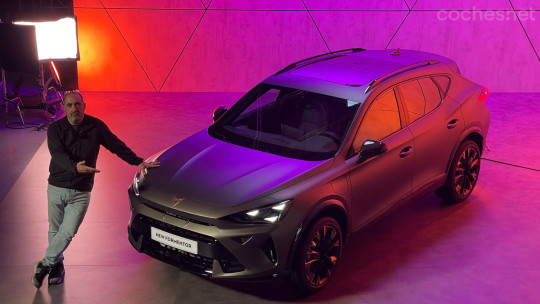
Los modelos Cupra León y Formentor comparten muchos elementos pero tienen diferencias importantes. Cupra ha decidido actualizar ambos coches, incluyendo novedades estéticas, mecánicas y de equipamiento. Las actualizaciones afectan al diseño exterior, con cambios en la parrilla, faros y colores de carrocería.
Cambios en el diseño exterior
Actualizaciones en el frontal y lateral
El rediseño en forma de nariz de tiburón cambia radicalmente la apariencia de ambos modelos. En el Cupra Formentor, la parrilla casi se elimina y se colocó el logotipo en el capó. Además, se cambiaron los faros, parachoques y tomas de aire. Por otro lado, el Cupra León adopta un diseño similar al Formentor, diferenciándose del Seat León. La firma luminosa de ambos modelos también fue modificada, con tres triángulos integrados en uno solo de mayor tamaño y faros matriciales.
En cuanto al lateral, se realizaron pocos cambios más allá de las molduras y las llantas. El Formentor presenta llantas de 18 o 19 pulgadas con ocho diseños diferentes, mientras que el León ofrece las mismas medidas pero con una opción adicional de llanta. Además, se añadieron dos nuevos tonos de carrocería mate en bronce y gris, y se mantuvieron los colores existentes, excepto el rojo que fue eliminado.
Novedades en el interior
Mejoras en la tecnología y equipamiento
El interior de los nuevos Cupra León y Formentor es idéntico y se destaca por la incorporación de una nueva pantalla de 12,9 pulgadas con un nuevo interfaz mejorado. Esta pantalla integra widgets, una barra de aplicaciones y de climatización de fácil manejo, además de controles retroiluminados. El sistema de sonido, desarrollado en colaboración con Senheisser, cuenta con 12 altavoces. El cargador inalámbrico tiene una potencia de 15 watios y los sistemas Apple Car Play y Android Auto funcionan de manera inalámbrica.
Además, el control del climatizador está integrado en la pantalla principal, facilitando el acceso a todas las funciones con un solo clic. El salpicadero presenta un nuevo patrón en 3D y se han agregado detalles en color cobre para mejorar el aspecto visual. Los asientos también experimentaron cambios en las tapicerías y materiales, con opciones de tapicería textil para los asientos sport y microfibra para los tipo Bucket.Los nuevos Cupra Leon y Formentor ofrecen una propuesta de diseño sostenible y respetuosa con el medio ambiente. La gama de motores incluye opciones de gasolina TSi, e-TSi (híbridos ligeros), diésel e híbridos enchufables con innovaciones en este último segmento.
Innovación en motores para Cupra Leon y Formentor
La gama de motores para ambos modelos es amplia y variada. Desde el motor básico de gasolina de 150 CV hasta las potentes versiones VZ con motores de hasta 333 CV, hay una opción para cada tipo de conductor. La inclusión de sistemas como el Torque Splitter y frenos Akebono demuestran el enfoque deportivo de estos vehículos.
Tecnología y seguridad en los nuevos modelos
Además de la potencia de los motores, los Cupra Leon y Formentor cuentan con tecnología avanzada en seguridad y asistencia al conductor. Desde un airbag central hasta un sistema de monitorización del conductor, estas innovaciones buscan mejorar la experiencia de conducción y la seguridad de los ocupantes.
Precios y disponibilidad de los Cupra Leon y Formentor
Los nuevos Cupra Leon y Formentor estarán disponibles para la venta en el tercer trimestre de 2024, justo después del verano. Con una amplia oferta de motores y tecnología avanzada, estos modelos prometen ser una opción atractiva para los amantes de la conducción deportiva y sostenible.
Las entregas de los nuevos Cupra Leon y Formentor comenzarán pasado el verano. Los nuevos modelos ofrecen una variedad de opciones de motor, tecnología avanzada en seguridad y asistencia al conductor, así como un diseño sostenible y respetuoso con el medio ambiente.Resumen: Cupra presenta el restyling de los León híbridos con nueva estética y mejoras tecnológicas, manteniendo precios similares a los actuales.
Cupra presenta los nuevos León híbridos
Cupra ha revelado el rediseño de los León híbridos, con un precio inicial de 37.280 euros y entregas programadas para otoño. Aunque aún no se han anunciado los precios para el resto de las versiones, se espera que sean similares a los actuales, con un ligero aumento debido al mayor equipamiento, pero manteniendo un nivel similar al actual.
Nueva estética y mejoras tecnológicas
Uno de los aspectos más destacados de los rediseños es la adopción de la nueva estética característica de Cupra, que los diferencia claramente de los modelos de Seat. Además, se ha mejorado considerablemente la potencia de las versiones híbridas enchufables, con una autonomía de más de 100 km y la posibilidad de recargar en continua. Estas mejoras permitirán un uso eléctrico en la mayoría de los desplazamientos diarios.
Actualización por Juan Carlos Grande
Juan Carlos Grande ha actualizado el artículo con información sobre el precio y la disponibilidad del nuevo Cupra Formentor eTSI 150 CV.
0 notes
Text
Choosing Perfect Riders: Comparing Yamaha Models and Prices in Bangalore’s Showrooms
Yamaha is one of the most trending and loved bike brands globally. It is well-known for its style, efficiency, and customer satisfaction. Apart from this, Yamaha has established a strong position in India and also in the hearts of millions as a “dream bike.”
In this blog, Perfect Riders, the authorized Yamaha dealer in Bangalore, takes the initiative to bring about a holistic comparison of Yamaha models and prices for bike lovers.
Top 5 Yamaha Models and Prices
Let us take a sneak peek into the best top 5 Yamaha models and prices which are making a buzz.
Yamaha FZ S FI:
Key features:
Bluetooth-enabled street bike in 6 variants
Weight 135 kgs
Colors: Available in 7 vibrant colors
Quick initial pick-up with smooth acceleration with 149 cc air-cooled 4-stroke powerful EI engine
Excellent shock-absorbing performance with a light-weight motocross suspension unit
Blue core engine with superior acceleration
Comfortable two-level seat with excellent cushioning and LED flashers
Deluxe colored wheels to grab attention with 3D emblem for a premium look
Advanced and enhanced muffler sound
Bosh anti-lock FZ braking system
In-built stand engine cut-off switch in case you forget to remove the side stand
140 mm wide radial tires for good grip and low rolling resistance
The price starts at 1,05, 000
2. Yamaha FZ X:
Key features:
Crossover bike with neo-retro design, and future-proof features
Weight -139 kgs
Colors- Available in 4 colors, metallic, chrome, and matt version
Gives extra mileage for 48 to 55 kml/l with a 149 cc air-cooled 4-stroke powerful EI engine
LCD instrument cluster screen compatible with Yamaha Y-connect app
Bifunctional LED headlight and tail light
Spacious single-piece seat with anti-resistant technology
Comfort ride with Bosch single-channel ABS and telescopic suspension
One of the most high-demanding models of Yamaha
The price starts at 1,36, 000
3. Yamaha MT 15:
Key features:
Dynamic, lightweight, pure-bred hyper-naked bikes
Impeccable style
Weight 135 to 139 kg
Available in many metallic and matt blue and black shades
Ice Fluo-Vermillion color variant which is an exclusive feature
Well-built muscular spherical tank
Bi-function LED headlights
Uni-level seat with a better riding position
140 mm super-wide radial rear tire gives good grip
BS6 complaint 155cc engine with first ever Variable Valve Actuation (VVA)
In-built side stand engine cut-off switch
High-performance systems with torque even at low RPM
The price starts at 1,65,000
4. Yamaha YZF R15 V4:
Key features:
The fourth generation of the R15 series
Weight 141 kgs
Available in 7 different colors which include metallic red, dark knight, racing blue, metallic gray, intensity white, MotoGP edition, and vivid magenta metallic.
Equipped with a digital instrument screen, compatible with the Y-connect app
Class D bi-functional LED headlight with increased brightness
Aerodynamic body design with rider reach at top speed in no time
Upside-down front suspension fork with improved rigidity and better stability
Dual-channel ABS 140 mm super-wide radial read tire for good grip on the road
In-build side stand with a cut-off switch
155 cc liquid-cooled fuel injection engine with VVA
Traction control system and a quick shifter
Delivers 18.4 ps with slip and assist clutch
The price starts at 1,80,000
5. Yamaha YZF -R3:
Key features:
Sporty bike with touring ergonomics
Weight 167 kgs
Available in 2 colors – Racing Blue and Magma Black
The silky smooth 321 cc parallel-twin- mill is absolutely a charm
Agile nature, and linear power delivery.
Crowned as Performance Motorcycle of the Year under 500 cc at Car Bike Awards 2024
Dual channel Anti-lock Braking System, reliable braking on slippery roads
High-safety performance and enhanced grip
LED tail lights with different power modes
Disc brakes in front and rear with the unified braking system
Tubeless tyres and alloy wheels
The price starts at 4,65,000
Wondering which Yamaha bike to choose? This is a shout-out call for all bike lovers out there. You can be one of the perfect riders with Yamaha bikes to enjoy a great riding experience like never before. Just get connected to one of our experts at Perfect Riders, the best Yamaha Showroom, in Bangalore, to ride your passion on the roads with pride!
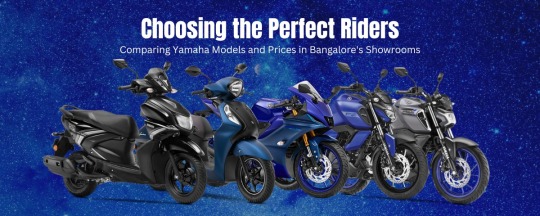
#yamahashowroombangalore#bluesquaredealersinbangalore#authorisedyamahadealersinbangalore#yamahadealersbangalore#perfectriders
0 notes
Text
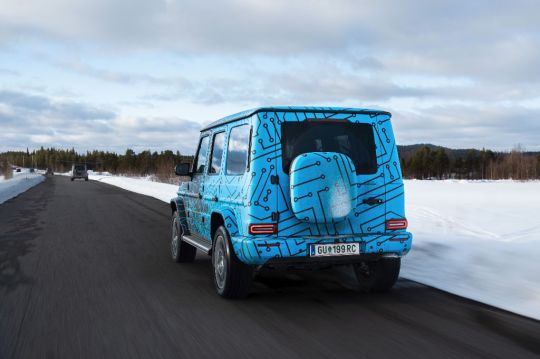
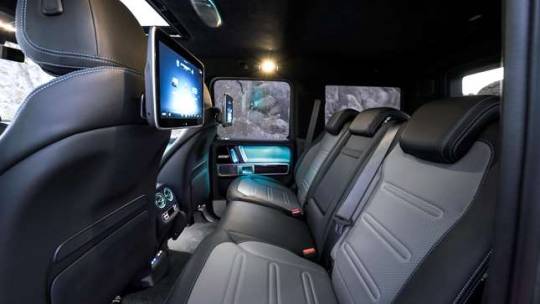

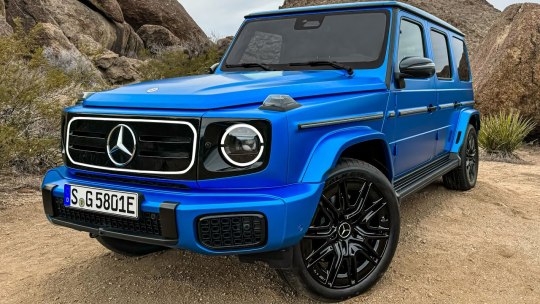
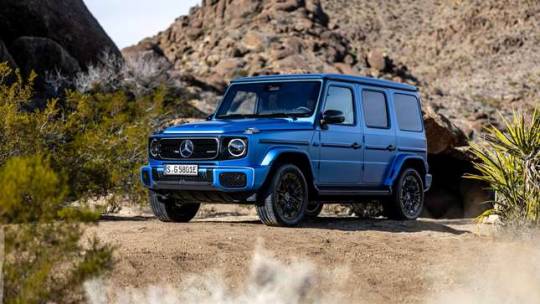
But what specification does the Edition One have? As you would imagine for the price tag, this EV will be pretty robust! As standard this has 20” alloys, Active Multicontour Seat Package, Ionisation of air pack, AMG Line finish (floor mats, sill protection and sill panels), Burmester 3D sound, Comfort Package (keyless-go, temperature controlled cupholder and wireless phone charging, heat-insulated dark tinted glass), Night Package (darkened maps and black radiator grille), side running boards, sliding sunroof, SUPERIOR Line interior (G-ROAR and Nappa leather instrument panel), ambient lighting, metallic paint MANUFAKTUR logo projection, memory function front seats, multifunction steering wheel in Nappa leather, Off-road screen, Warmth Comfort Pack (heated steering wheel and windscreen), Nappa leather seats, dash cam, Engineering Pack (Assistance Package and Parking Package included), smartphone integration, URBAN GUARD, torque vectoring and ladder-type frame.
In terms of additional options, choose between the Opalite White Mango, Obsidian Black, Grey, Opalite White Bright and South Seas Blue Mango (which is used on these images). One cool addition, is the charging cables at the rear door in replacement of the spare tyre which is usually housed here.
But how will the G-Class electric perform? The AWD option operates from 4 independent motors, and has a usable battery of 116 kWh, which delivers some 432 kW (or 587hp). This means performance of 112mph top speeds and 0-62 times of 4.7 seconds. In terms of charging capability, the Merc will have a maximum 11 kW AC (for 12 hour 0 - 100% charging sessions) and 200 kW DC (for 32 minute 10 - 90% charging sessions) on hand. An impressive 879 lb-ft of torque does show this EV definitely means business. Testing is still ongoing but it is rumoured to deliver WLTP ranges of 293 miles, which is likely to be around 230 - 250 miles in real world conditions.
#mercedes#mercedes g wagon#mercedes g580#g class electric#electric cars#car leasing#car lease#electric
0 notes
Photo
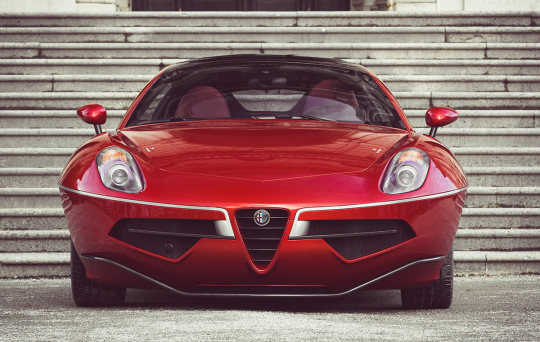
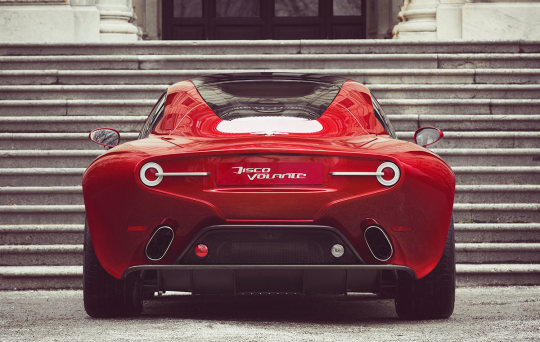
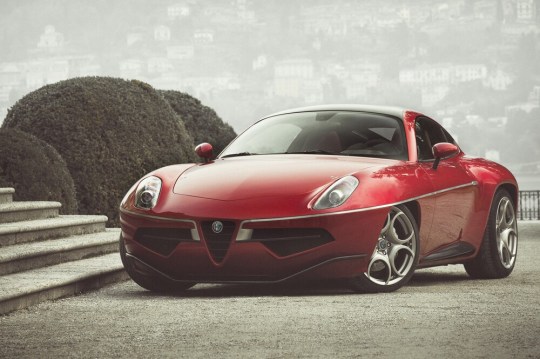
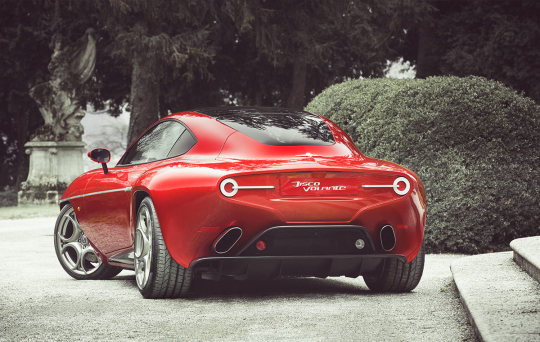
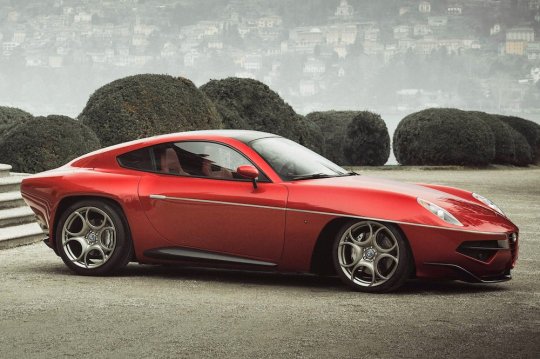
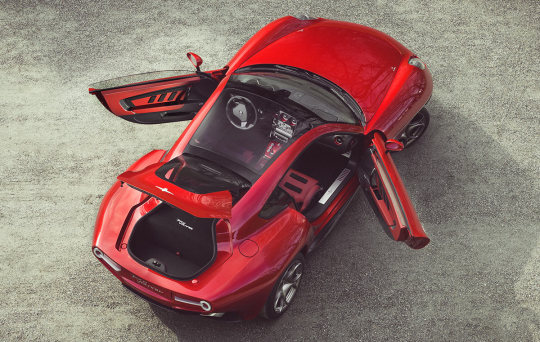


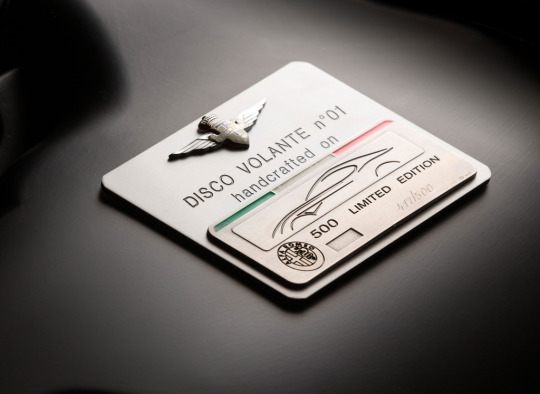
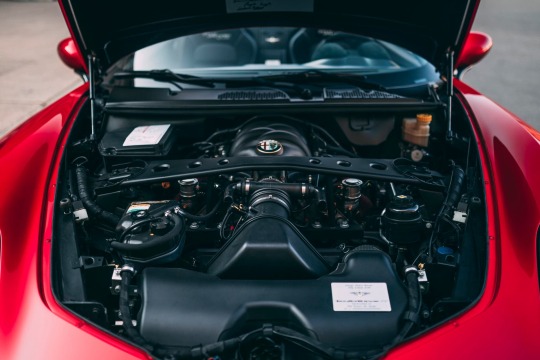
Alfa Romeo Disco Volante by Touring Superleggera
The Disco Volante is a two-seater Gran Turismo. It is based on the Alfa Romeo 8C Competizione coupé with its front-central mounted 4.7 litre V8 engine and a transaxle rear drive with unmodified specifications. Each unit, of which the construction requires 4,000 hours of manual work.The present Disco Volante celebrates the myth of the 1952 style icon. The new design briefing required to blend ingredients as innovation, emotion and aerodynamic properties into a timeless and essential shape.During the development stage, Head of Design Louis de Fabribeckers and his team cooperated with the engineers on an almost daily basis. “We focused on the preservation of the design essence. – says de Fabribeckers – Once the design frozen, we had to understand the manufacturing problems and solve them right away without compromising the design.”In consistency with the car’s design philosophy the interior has a ‘science fiction’ feel to it. Part of this ‘spaceship’ atmosphere was created by elements like the red LED interior light profiles. Also, aeronautics has been the inspiration for parts like the dashboard, instruments and seat adjustment lever.The Alfa Romeo 8C Competizione chassis was chosen for its light and rigid structure and its outstanding dynamic properties. Therefore it forms the perfect basis for the coach-built bodywork of the Disco Volante, integrally conserving the rolling chassis and drive train.The Alfa Romeo 8C’s steel space-frame and other structural elements were retained to guarantee torsion stiffness, high performance and the quality standard. The frame members and the central carbon cell remained unchanged. Elements of the underpinning and the body, such as the engine bay and firewall, the windscreen and cowl, the a-pillar and the locks and hinges have been retained too, just as the dashboard and instruments, the pedals and the steering wheel. Parts like doorframes, the roof frame and the c-pillar have been modified to match with the new shape.The layout of a front-central mounted engine, a transaxle transmission and rear-wheel drive offers an optimal weight distribution of 49-51% between the front and rear axles. To ensure excellent handling the front and rear double-wishbone suspension scheme is combined with hub carriers of forged aluminium and additional trailing arms for the rear suspension.The lightweight and compact 4.7 litre V8 engine delivers 450HP and 480Nm peak torque. It is coupled with a six-speed sequential transaxle gearbox with electronic control and paddle-shift gear selection. Together with a limited-slip differential and a state-of-the-art braking system with large diameter, ventilated discs a precise, dynamic and proactive drive is ensured. The Disco Volante can accelerate from 0 to 100 km/h (0-62 mph) in 4,2 seconds and has a top speed of about 290 km/h (181 mph).
All new and modified components of the Disco Volante have been CAD designed. In this process, which covers feasibility, safety, homologation, aerodynamics and structural analysis, the most advanced IT tools and simulation techniques have been used.
Since torsion stiffness and noise reduction are of critical importance, special attention has been paid to the under-body structure and its elements, like the tubular frames supporting the rear wings and bumper, and the roll bar joining the c-pillars. Other complex design issues were the tailgate hinges, the 3d-cambered door window, and the front wheel covers.
The Disco Volante was then submitted to a CFD aerodynamic study to enhance the airflow and ensure optimal downforce in the rear section. After that, FEM calculations were run to assess resistance and rigidity of all parts subject to homologation.
Touring Superleggera is synonymous with the manufacture of lightweight bodywork. The weight advantage of aluminium is one of the assets of Touring Superleggera’s construction methods. Nowadays however, the craft of hand-beating aluminium panels is combined with the use of carbon fibre reinforced plastic (CFRP). For the Disco Volante, Touring decided to use this combination of aluminium and CFRP. This has been the result of a study conducted to define optimal use of materials for the bodywork in terms of weight, resistance, precision, finish and quality, and ease of repair in case of damage.
The CFRP is used for specific components like the front bumper and grille, the bonnet, the skirts, the boot lid and the integrated rear-window frame. The bonnet and the boot lid are sandwich-built with Nomex filler in-between to obtain a better stiffness/weight ratio and to dampen vibration and noise.
The aluminium panels are hand-beaten using an epoxy mould. Since the inner frames of most parts of the bodywork are made of CFRP, this requires gluing of aluminium on carbon fibre. This technique adds to the rigidity as the glue has structural properties.
The body panels are pre-assembled on a laser measurement platform using a jig. This ensures that the strict tolerance required is respected. After adjustment, the panels are either welded or glued. The body-in-white is then used to preassemble and fit all trim components, brightware and moulding.
160 notes
·
View notes
Video
vimeo
"Electric Beast Unleashed: Mercedes' New All-Electric G-Class Promises Off-Road Revolution" from Test Miles on Vimeo.
Mercedes-Benz has turned heads again, but this time it’s not just the luxury or the legacy—it’s the electricity. Say hello to the all-new Electric G-Class, the G 580 equipped with EQ technology, a vehicle that promises to redefine what an electric SUV can be.
While many manufacturers have introduced electric vehicles (EVs), Mercedes has taken a bold step into the future with this design. They've seamlessly merged their iconic G-Class luxury with cutting-edge, sustainable technology, crafting an SUV that boasts both high performance and eco-friendly credentials.
The heart of the G 580 lies in its four individually controlled electric motors paired with a two-speed transmission. This isn’t just about smooth city driving; it’s about conquering terrains with an intelligent off-road crawl function, G-Turn capability allowing the vehicle to rotate on the spot, and G-Steering for nimble maneuvers in tight spaces. These features ensure the electric G-Class is as much a beast off the road as it is a beauty on the street.
Diving deeper into its off-road prowess, the vehicle impresses with a fording depth of 33.5 inches and a LOW RANGE gear that maximizes torque for challenging terrains. Virtual differential locks through torque vectoring add to its robust capabilities, ensuring that the electric G-Class doesn’t just match its combustion counterparts—it exceeds them.
Performance-wise, the electric G-Class is a powerhouse with a stunning 579 horsepower and a torque of 859 lb-ft, which rockets the SUV from 0-60 mph in under five seconds. Yet, it’s not just about speed; the integration of the battery within the ladder frame lowers the center of gravity, enhancing stability and handling, while an independent front suspension and a newly developed solid rear axle ensure it rides as good as it looks.
The SUV doesn't just perform; it turns heads. Mercedes has enhanced the classic G-Class silhouette with flared rear wheel arches, air curtains, a redesigned hood, and A-pillar trim to improve aerodynamics. A spoiler lip on the roof strip further helps in reducing noise, making for a quieter ride.
Inside, the G-Class brings luxury into the modern age with the latest MBUX system, climate-controlled cup holders, and inductive charging. For audiophiles, the Burmester® 3D Surround Sound System with Dolby Atmos® offers an unmatched auditory experience. Additional high-tech features like the Transparent Hood function enhance safety by increasing visibility, and customization options are expanded through an enhanced MANUFAKTUR range.
What's more exciting for prospective buyers are the exclusive touches such as the black panel grille with an LED light strip and aerodynamic black wheels. These design elements ensure that the vehicle stands out, not just for its performance but also for its aesthetic appeal.
Mercedes’ electric G-Class isn't merely an evolution; it’s a revolution in the luxury SUV market, offering a perfect blend of tradition and futuristic technology. With its debut, Mercedes isn't just paving the way for future electric models; they're setting the bar incredibly high. This isn't just a vehicle; it's an experience—an electric marvel that promises to keep your pulse racing, whether you're navigating city streets or exploring rugged landscapes.
For those ready to embrace a greener future without sacrificing luxury or capability, the new electric G-Class is your calling card. Mercedes-Benz has not just electrified a vehicle; they have electrified the very essence of adventure.
0 notes
Photo

New Post has been published on https://www.vividracing.com/blog/ford-bronco-raptor-plug-play-tuning-box-gains-70hp-video-inside/
Ford Bronco Raptor Plug & Play Tuning Box Gains 70hp - Video Inside!

The Ford Bronco Raptor is the beast of the offroad machine we have all been waiting for since the 6th generation Bronco was reintroduced. With its 418hp 3.0L twin turbo Ecoboost engine, this is screaming to be touched and unleash its hidden potential. With an entire line of Plug and Play tuning box kits available for turbocharged cars, trucks, and SUVs, one of VR Tuned most successful sales product has been for the Ford Bronco 2.7L Ecoboost. Well now its time for the Bronco Raptor 3.0L Ecoboost to choice in with the gains!
Being lucky enough to have the Ford Bronco Raptor here at Vivid Racing, we were able to strap this thing down to our Mustang Dyno and see what it made stock. Once we got our baseline test of around 334 rear wheel horsepower, we could start the development of the tuning box map. The tuning boxes are universal and get preprogrammed to the customers vehicle before they are shipped. And the harness for the Ford Bronco Raptor is one already available as its used in the Bronco 2.7L as well as the Ford F-150 3.5L Ecoboost engine. Connecting the harness to the Manifold Pressure and Boost Pressure sensor is all it takes to bring this live. The sensors are very easy to access with one being right in front of the throttle body and the other just under the intake tube that goes across the top of the engine. With a 10mm socket just remove a metal bracket to gain access to this sensor.
Utilizing our logging device we were able to test different settings of some base maps that are then preset for the tuning box to be in a safe range for 91-93 octane. Once we were happy with the tweaks made, we were able to complete our after runs to compare to our baseline test. Using setting 6 on the tuning box which is preferred, we saw some pretty strong gains throughout the entire midrange. Both horsepower and torque picked up about 50 to the wheels (70-80 to the crank). Power can be measured to the crank which is standard HP or to the wheels which is RWHP. Dyno graphs will show RWHP. So when Ford says the vehicle makes 418HP, in actuality, on our Mustang Dyno with 91octane and our warm ambient temperature of 90F here in Arizona, we saw about a 20% drivetrain loss giving 334rwhp. But with the tuning box we achieved about 380rwhp. That puts this Bronco Raptor at 480HP to the crank!
The tuning box found a neat home to be mounted right behind the passenger side intake box. Because this is a plug and play device, it can easily be removed for major warranty purposes should you choose to do so. There is not trace or record to the ECU since we are not altering the ECU parameters directly. The best part is the entire kit is Bluetooth operated via an IOS or Android app.
Want to know more? Watch our video here.
youtube
Ready to order? Buy online here.
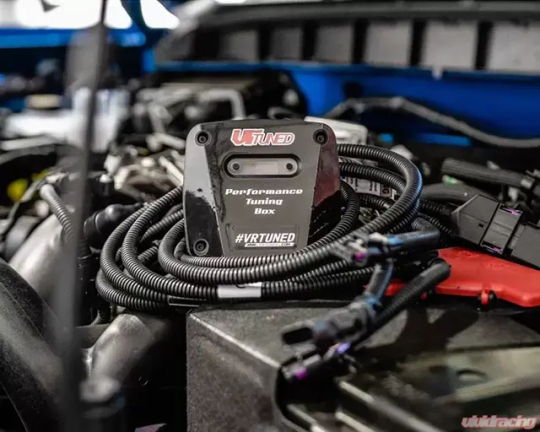

0 notes
Text
Navigating Nepal’s Roads: Stylish Bikes in Nepal in 2024
Explore Nepal’s captivating landscapes and winding roads, where style meets performance and innovation in Yamaha’s 2024 lineup. With a commitment to redefine your ride, Yamaha introduces a collection of bikes that not only conquer terrains but also elevate your journey to new levels of elegance and power. Join us on a journey through the enchanting roads of Nepal, discovering the exquisite lineup designed to offer riders a symphony of style, performance, and innovation.
R15 V4: Racing Blue Symphony
Embrace the exhilaration of the track with the R15 V4, a visual symphony in Racing Blue that echoes Yamaha’s MotoGP excellence. Meticulously designed for speed and performance, it captivates with sharp lines, an aerodynamic fairing, and twin LED headlamps, presenting a futuristic machine on the road. Since its release, the Yamaha R15 has stood out for its sleek design, winning the hearts of motorcycle enthusiasts who appreciate its aesthetic finesse. The lightweight body and nimble handling further elevate its appeal, making it an excellent choice for city commutes and highway adventures. In essence, the R15 V4 is a harmonious blend of style and high performance, redefining the riding experience for those who seek a two-wheeled companion that’s as visually striking as it is thrilling on the road.
MT-15: Elegance in MT-09’s Shadow
The captivating “Master of Torque,” the Yamaha MT-15, an elegant sibling of the MT-09 dynasty that transcends mere street-fighting. With its fierce design and Bi Functional LED headlights reminiscent of a samurai, this dark and stylish street fighter not only signifies a powerful lineage but becomes a visual embodiment of the dark side of Japan and its enigmatic warriors. Navigating Nepal’s streets, the MT-15 dominates with a bold aesthetic, making a distinctive impact as a sleek, powerful, and visually arresting two-wheeled masterpiece that seamlessly blends the mystique of Japan’s dark side with the allure of contemporary style.
R15M: Racing Brilliance Unleashed
Connect with the ultimate racing machine as you ride the R15M. The R15M showcases Yamaha’s dedication to innovation, with the R15M taking the racing quotient to new heights. Its deluxe features, including new graphics, a Yamaha 3D emblem, and a special seat, make it a visual standout. The R15 V4, with its modern backlight design, adds a stylish element to the motorcycle’s aesthetics. Yamaha’s commitment to distinctive features ensures that these bikes not only perform but also look exceptional on the road.
FZS FI V3 Deluxe: Upgraded Style, Unmatched Grace.
The Yamaha FZ-S FI Version 3.0 is a masterpiece in the world of motorcycles, seamlessly blending stunning aesthetics with cutting-edge technology. The introduction of striking new color options, Metallic Grey and Navy Blue, adds a touch of sophistication to this already stylish ride. The revamped backlight design not only enhances the modern appeal but also sets the FZ-S FI V3.0 apart from the crowd. Renowned for its exceptional handling and muscular design, this deluxe version showcases Yamaha’s commitment to Sportiness, Style, and Excitement. Powered by a Fuel Injection 149cc engine, it’s not just about looks – it’s about an exhilarating riding experience. As a proud member of the iconic FZ series, a trailblazer in the Nepalese market since 2008, the FZ-S FI V3.0 continues to redefine standards, ensuring riders have access to a motorcycle that not only looks fantastic but also delivers pure riding joy.
FZS V3 X-Connect: Stylish Roadster Mastery
Indulge in the mastery of responsive roadster performance with the FZS V3 X-Connect, where style takes center stage alongside unyielding performance and optimum mileage. This bike doesn’t just excel on the road; it excels with a distinctive sense of style, boasting sharp lines, a muscular fuel tank, and a responsive LCD instrument cluster that creates a visual symphony of style and functionality. Engineered for unparalleled performance, the FZS V3 X-Connect transcends being just a roadster; it stands as a responsive masterpiece. With advanced Yamaha Blue Core concept and features like ‘Connect-X,’ this bike offers an unmatched performance experience. The stylish design, including sharp lines, a muscular fuel tank, and a responsive LCD instrument cluster, adds to its visual appeal, making it the top choice for riders seeking both style and functionality.
FZ FI V3 BS6 Standard: Style Utility Blend
Since 2008, the FZ series has rightfully earned the title of “Lord of the Street,” and the FZ FI V3 BS6 Standard proudly carries this legacy forward. FZ FI V3 BS6 Standard, is a roadster where style effortlessly converges with utility, creating a two-wheeled masterpiece that goes beyond sheer performance and becomes a striking visual statement on the streets. This revolutionary choice seamlessly blends style and functionality, boasting sharp lines and advanced BSVI engine technology. More than a performance powerhouse, its aggressive and stylish design, featuring sharp lines, LED headlights, and a muscular fuel tank, positions it as a visual marvel. Yamaha sets new standards in the fusion of style and functionality with this naked sports bike, making it an irresistible option for those desiring power with a touch of sophistication.
FZS FI V2: Sporty Elegance, Tested Performance
Captivating hearts since 2014, the FZ V2 transcends being a mere bike; it stands as an emblem of sporty elegance on every road. Its design, marked by a minimalistic yet stylish approach, featuring an LED headlight and muscular fuel tank, positions it as the perfect companion for both city commutes and highway adventures. From the sleek LED headlight to the skid free Split Seat, this bike radiates a minimalistic charm that perfectly complements its inherently sporty design. A visual embodiment of the Lord of the Street’s DNA. This affordable fuel-injected excellence isn’t just about conquering roads; it’s about doing so with a style that reflects Yamaha’s legacy. Yamaha’s attention to style doesn’t compromise on performance, making the FZS V2 a top choice for those who seek both power and visual appeal.
FZX: Urban Explorer – Stylish Comfort Redefined
Embark on a journey of adventure and comfortability with the FZX, a neo-retro bike meticulously designed to stand out, featuring a round headlight, exposed frame, and retro-style fuel tank that goes beyond aesthetics, infusing every ride with a unique blend of adventure and comfort, creating a visual expression of individuality on the roads. The FZX, a neo-retro bike designed for the unique, perfectly combines striking retro aesthetics with future-proof technologies. Its round headlight, exposed frame, and retro-style fuel tank make it stand out. The Y-connect app seamlessly blends classic elements with modern features, offering a comfortable and visually distinctive riding experience for both long tours and daily commutes.
In conclusion, Yamaha’s 2024 lineup isn’t just a collection of bikes; it’s a symphony of style, power, and innovation. Each model in this array offers a unique riding experience, ensuring that every journey through Nepal’s roads becomes an adventure worth remembering. As you navigate the diverse landscapes, let Yamaha be your companion in style and performance, making every ride a statement of elegance on the enchanting roads of Nepal.
0 notes